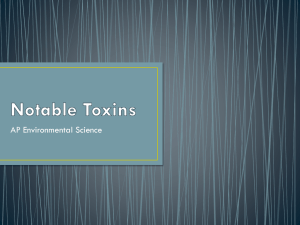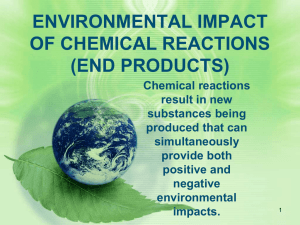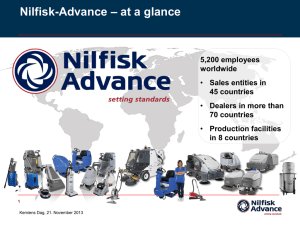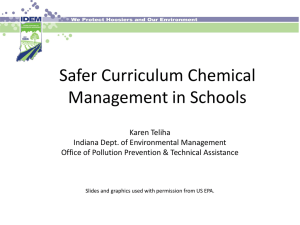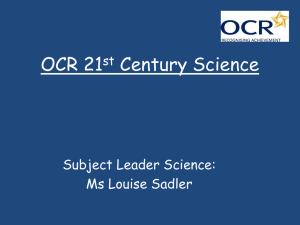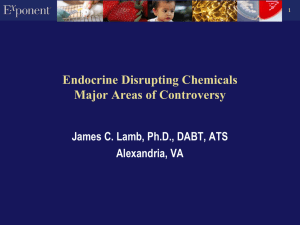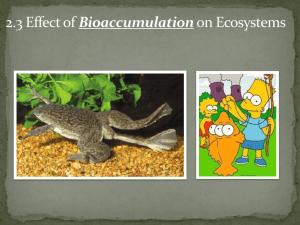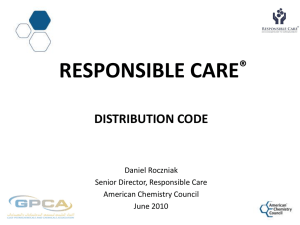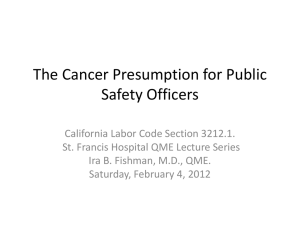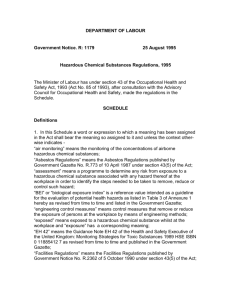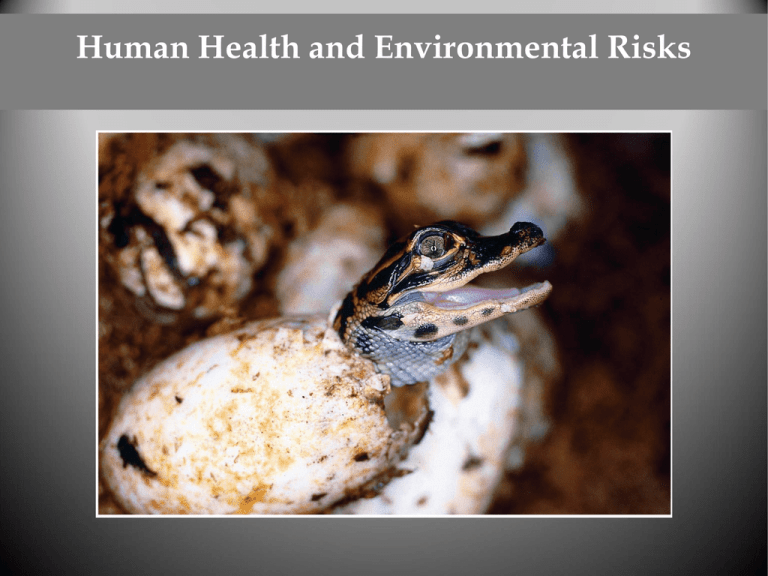
Human Health and Environmental Risks
Four categories of human health
risks
Physical
Biological (viruses, bacterial infections)
Chemical (disinfectants, pesticides)
Cultural/Lifestyle (drinking, smoking, bad diet, crime in
(floods, blizzards, landslides, radon, UV exposure)
neighborhood)
Biological Risks
Infectious diseases- those caused by infectious
agents, known as pathogens.
Example: pneumonia and Flu
Also referred to as: transmissible, contagious or
communicable diseases.
Where you live and your level of poverty may
increase the probability of contracting some
infectious diseases.
Biological Risks
Epidemic – An outbreak of an infectious
disease that is limited to one area or
region.
Pandemic – If outbreak of a disease
spreads globally.
Biological Risks
Chronic disease- slowly impairs the functioning of a
person’s body.
Acute diseases- rapidly impair the functioning of a
person’s body.
Historical Diseases
Plague
Malaria
Tuberculosis
Cholera
Dysentery
Emergent Diseases
HIV/AIDS
Ebola
Mad Cow Disease
Bird Flu
West Nile Virus
SARS
Antibiotic resistant TB
Agencies
CDC – Center for Disease Control and
Prevention (United States)
WHO – World Health Organization (global)
Solutions for Reducing Infectious
Disease
Improving drinking water conditions in
developing countries
Decreasing malnutrition to improve
immune system
Implementing global education programs
to prevent HIV/AIDS
Increasing availability to
vaccines/antibiotics
Reducing unnecessary use of antibiotics in
humans and livestock
Chemical Risks
Toxicology – Study of the detrimental effects of
chemicals on both humans and wildlife
Key characteristics that cause a chemical to be
toxic include:
Persistence – not easily degraded/broken down
Solubility – fat soluble chemicals will accumulate
in body tissues, water soluble chemicals will be
dissolved easily in bodies of water
Biomagnification – Increased concentration of
chemical through the food chain.
Bioaccumulation
bioaccumulation- an increased concentration
of a chemical within an organism over time
Biomagnification
Biomagnification- the
increase in a chemical
concentration in
animal tissues as the
chemical moves up
the food chain.
Dose-Response Studies
LD50- lethal dose that kills 50% of the
individuals
ED50- effective dose that causes 50% of the
animals to display the harmful but nonlethal
effect (referred to as sublethal effects)
Because of the short duration of these
experiments, referred to as acute studies
Synergistic interactions- when two risks
come together and cause more harm that
one would. For example, the health
impact of a carcinogen such as asbestos
can be much higher if an individual also
smokes tobacco.
Dose-response curve
Threshold = dose at
which response begins
LD50 = dose
lethal to 50% of
test animals
Do The Math
Based on a LD50 pesticide study on a rat, what
amount of the pesticide would be considered safe
for a mammal?
LD50 ÷ 10 (mammal)
LD 50 = 2mg/kg of mass ÷ 10 = 0.2 mg/kg of mass
LD50 ÷ 1000 (humans)
LD 50 = 2mg/kg of mass ÷1000 = 0.002 mg/kg of
mass
Problems with Toxicity Testing
There are many issues in accurately assessing
toxicity of chemicals….
Genetic Variability – individuals can exhibit
different response to a given level or type of
chemical
Test only one response to one chemical at a
time, difficult to determine synergistic effects
Type of exposure may effect response (acute
versus chronic)
Regulating agencies may rely on Industry
sponsored research
Chemical Risks
Neurotoxins- chemicals that disrupt the nervous system
Carcinogens- chemicals that cause cancer
Teratogens- chemicals that interfere with the normal
development of embryos or fetuses
Allergens- chemicals that cause allergic reactions
Endocrine disruptors- chemicals that interfere with the
normal functioning of hormones in an animal’s body
Routes of Exposure
Many health hazards exist indoors
•
•
•
•
•
Substances in plastics
and consumer products
Lead in paint and pipes
Radon
Asbestos
PBDE fire retardants
Chemical
Sources
Type
Effects
Arsenic
Mining, Groundwater,
Treated wood products
Carcinogen
Cancer
Asbestos
Building Insulation
Carcinogen
Lung Cancer
Radon
Soil, Water, Bedrock
Carcinogen
Lung Cancer
Vinyl Chloride
Industry, water from
vinyl chloride pipes
Carcinogen
Cancer, especially liver
cancer
PCBs (Polychlorinated
biphenyls)
Industry (electrical
insulator, fire retardant,
pesticides, adhesives)
Carcinogen
Cancer
Phthalates
Used in production of
Carcinogen
plastics and as solvents
Reproductive damage
and cancers
Bisphenol A
Used in production of
plastic bottles and food
containers
Reproductive cancers
Benzene
Emissions from burning Carcinogen
coal , tobacco smoke
Cancer
Dioxins
Class of chemical
compounds in
manufacturing of some
herbicides
Bioaccumulates,
causes cancer
Carcinogen
Carcinogen
Chemical
Source
Type
Effects
Thalidomide
Morning Sickness
Medication prescribed
in the early 1960s
Teratogen
Birth Defects
Alcohol
Alcoholic beverages
Teratogen
Fetuses with reduced
fetal growth, brain
damage
Benzene
Emissions from
burning coal and oil,
tobacco smoke
Teratogen
Long term exposure
can cause birth
defects
Vinyl Chloride
Precursor to making
PVC
Teratogen
Birth Defects
The drug thalidomide, used to relieve nausea during
pregnancy, turned out to be a potent teratogen, and
caused thousands of birth defects before being banned in
the 1960s.
Chemical
Source
Type
Effect
Lead
Paint, gasoline
Neurotoxin
NS disorders, Death
Mercury
Coal burning, fish
consumption,
batteries, fluorescent
lights, smelting,
incineration of
municipal waste
Neurotoxin
Brain damage
Neurotoxin/Teratogen
Biomagnify through
food chain and cause
neuological damage
especially in fetuses
Heavy Metals (lead,
mercury, Arsenic,
Cadmium)
PCB’s
Industry, electrical
Neurotoxin/Teratogen
insulators, fire
retardants, adhesives,
pesticides
Brain damage,
especially in fetuses
Vinyl Chloride
Precursor to PVC
Neurotoxin
Brain damage
Bisphenol A
Plastic bottles and
containers
Neurotoxin
Neurological damage
http://www.youtube.com/watch?v=ihFkyPv1jtU
Link – Minamata Disease
Chemical
Source
Type
Effect
Atrazine
Herbicides
Endocrine Disruptor
Feminization of males, low
sperm count, damage to
sexual development ,
reduced penis size, having
both male and female sex
organs
DDT
Pesticide
Endocrine Disruptor
Biomagnifies, reproductive
damage, thin egg shells,
cancers in birds
Phthalates
Production of plastics,
solvent in some cosmetic
products
Endocrine Disruptor
Feminization of males, low
sperm count, damage to
sexual development ,
reduced penis size, having
both male and female sex
organs
Frogs show reproductive
abnormalities in response to
small doses of the herbicide
atrazine, researcher Tyrone
Hayes has found.
Others suggest that atrazine may
have effects on humans as well,
lowered sperm count, may also
be linked to increasing incidence
of breast and testicular cancers.
Endocrine Disruptor
Well Known Case Studies
• Love Canal Housing Development in Niagara Falls,
New York – Hazardous waste chemicals buried in
old canal leaked into homes, school yard, soil, and
ground water. Led to the passage of
Comprehensive Environment Response
Compensation and Liability Act (CERCLA) aka
“Superfund Act”
Well Known Case Studies
Minamata, Japan – mental impairments,
birth defects, and deaths caused by
mercury dumped in Minamata Bay by a
factory. The mercury was converted to
methylmercury, bioaccumulated in fish, and
biomagnified through food chains. Mercury
entered humans who ate a traditional fish
based diet.
http://www.youtube.com/watch?v=ihFkyPv1jtU
Know Well Known Case Studies
Bhopal, India – On December 2, 1984,
poisonous methyl isocyanate gas was
released accidentally by a Union Carbide
pesticide plant killing about 5,000 people
and causing serious health effects for
50,000 - 60,000.
http://www.youtube.com/watch?v=ELllSxnDS0g
Risk
•
•
•
Risk = the mathematical probability that some
harmful outcome will result from a given action,
event, or substance
Probability = a quantitative description of the
likelihood of a certain outcome
Harmful outcome could be defined as injury,
death, environmental damage, economic loss, etc.
Perception different from reality
Our perception of risks tends not to match statistical reality.
smoking
plane
crash
Risk assessment
• Analyzes risks quantitatively
• Measures and compares risks involved in
different activities or substances
• Helps identify and prioritize serious risks
• Helps determine threats posed to humans,
wildlife, ecosystems
Risk assessment
Involves:
Dose-response
analysis or other
tests of toxicity
•
• Assessing likely
exposure to the
hazard
(concentration,
time, frequency)
Risk management
•
•
•
Consider risk
assessments in light of
social, economic, and
political needs and
values.
Weigh costs and
benefits, given both
scientific and
nonscientific concerns.
Decide whether or not
to reduce or eliminate
risk.
Risk assessment and risk management inform policy
Following risk management, policy decisions are made.
Philosophical approaches
• “Innocent until proven guilty”:
Assume harmless until shown to be harmful
• Precautionary principle:
Assume harmful until shown to be harmless
Implications for product testing
• “Innocent until proven guilty”:
• Industry can introduce any products it wants.
• Government bears the burden of proof to
show if products are dangerous.
• Precautionary principle:
• Industry cannot introduce a product until it is
very thoroughly tested and shown convincingly
to be harmless.
Implications for product testing
•
•
Industry has
pressured
government to
take an “innocentuntil-proven-guilty”
approach.
Environmental
advocates have
pressured
government to
follow the
precautionary
principle.
Stockholm Convention
In 2001, a group of 127 nations gathered in Stockholm,
Sweden, to reach an agreement on restricting the
global use of some chemicals
12 chemicals were to be banned, phased out, or
reduced (aka “dirty dozen”)
These include DDT, PCBs, and certain chemicals that
are by-products of manufacturing processes.
International Treaty – Persistent Organic Pollutants
Treaty (POPs)
Signed but not ratified by United States

